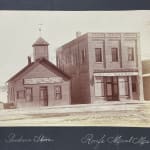[Winsted, Minnesota]
Album with Views of the Small MN Town, 1906
Photo album; printing-out-paper prints (20)
Each 4 ½ x 6 ½ inches
With captions to album pages.
With captions to album pages.
Further images
-
(View a larger image of thumbnail 1
)

-
(View a larger image of thumbnail 2
)

-
(View a larger image of thumbnail 3
)

-
(View a larger image of thumbnail 4
)

-
(View a larger image of thumbnail 5
)

-
(View a larger image of thumbnail 6
)

-
(View a larger image of thumbnail 7
)

-
(View a larger image of thumbnail 8
)

-
(View a larger image of thumbnail 9
)

-
(View a larger image of thumbnail 10
)

This charming album gives a photographic survey of the small town of Winsted, Minnesota. Located in Mcleod County, the village of Winsted was founded in July of 1857 when Eli...
This charming album gives a photographic survey of the small town of Winsted, Minnesota. Located in Mcleod County, the village of Winsted was founded in July of 1857 when Eli Lewis purchased the land north of Main Avenue from Baptiste Campbell, who was half-Sioux, and named it after his hometime in Connecticut.
The album is dated 1906 and contains views of the lake front, the Borgersrode hotel and telephone office, the Borgershrode Saloon, City Hall, the State Bank, the Presbiterian Church, the Bickmann & Millerbernd New General Store, First Street looking south, the Winsted Roller Mills, an unnamed photography studio (possibly the workplace of the album’s creator), the Convent School, the Catholic Parish, the Produce Store and Roulf’s Meat Market, the Public School, the McRoy Building, the Campbell Hardware Store, John Roulf’s residence, the Blacksmith Shop, the William Weaver Hardware Store, and the William Weaver residence.
The album is dated 1906 and contains views of the lake front, the Borgersrode hotel and telephone office, the Borgershrode Saloon, City Hall, the State Bank, the Presbiterian Church, the Bickmann & Millerbernd New General Store, First Street looking south, the Winsted Roller Mills, an unnamed photography studio (possibly the workplace of the album’s creator), the Convent School, the Catholic Parish, the Produce Store and Roulf’s Meat Market, the Public School, the McRoy Building, the Campbell Hardware Store, John Roulf’s residence, the Blacksmith Shop, the William Weaver Hardware Store, and the William Weaver residence.
![[Winsted, Minnesota], Album with Views of the Small MN Town, 1906](https://artlogic-res.cloudinary.com/w_1600,h_1600,c_limit,f_auto,fl_lossy,q_auto/artlogicstorage/dollc/images/view/e46c18cd31ebe4c1a9e08b63204c8c64j/daniel-oliver-winsted-minnesota-album-with-views-of-the-small-mn-town-1906.jpg)
![[Winsted, Minnesota], Album with Views of the Small MN Town, 1906](https://artlogic-res.cloudinary.com/w_1600,h_1600,c_limit,f_auto,fl_lossy,q_auto/artlogicstorage/dollc/images/view/2f8946aef77464e4e28f5e3a9e786855j/daniel-oliver-winsted-minnesota-album-with-views-of-the-small-mn-town-1906.jpg)
![[Winsted, Minnesota], Album with Views of the Small MN Town, 1906](https://artlogic-res.cloudinary.com/w_1600,h_1600,c_limit,f_auto,fl_lossy,q_auto/artlogicstorage/dollc/images/view/744dfd9a0e1bb4ff6c07eb8d3b7d2de6j/daniel-oliver-winsted-minnesota-album-with-views-of-the-small-mn-town-1906.jpg)
![[Winsted, Minnesota], Album with Views of the Small MN Town, 1906](https://artlogic-res.cloudinary.com/w_1600,h_1600,c_limit,f_auto,fl_lossy,q_auto/artlogicstorage/dollc/images/view/34fc69672c20e2ca0656fe229844d182j/daniel-oliver-winsted-minnesota-album-with-views-of-the-small-mn-town-1906.jpg)
![[Winsted, Minnesota], Album with Views of the Small MN Town, 1906](https://artlogic-res.cloudinary.com/w_1600,h_1600,c_limit,f_auto,fl_lossy,q_auto/artlogicstorage/dollc/images/view/09246f87c31f03db814e587ba6c0abb1j/daniel-oliver-winsted-minnesota-album-with-views-of-the-small-mn-town-1906.jpg)
![[Winsted, Minnesota], Album with Views of the Small MN Town, 1906](https://artlogic-res.cloudinary.com/w_1600,h_1600,c_limit,f_auto,fl_lossy,q_auto/artlogicstorage/dollc/images/view/486e00bcb734069dc3be043db2efa7b8j/daniel-oliver-winsted-minnesota-album-with-views-of-the-small-mn-town-1906.jpg)
![[Winsted, Minnesota], Album with Views of the Small MN Town, 1906](https://artlogic-res.cloudinary.com/w_1600,h_1600,c_limit,f_auto,fl_lossy,q_auto/artlogicstorage/dollc/images/view/1fd6dba19ec0b287493b2047f5f52b72j/daniel-oliver-winsted-minnesota-album-with-views-of-the-small-mn-town-1906.jpg)
![[Winsted, Minnesota], Album with Views of the Small MN Town, 1906](https://artlogic-res.cloudinary.com/w_1600,h_1600,c_limit,f_auto,fl_lossy,q_auto/artlogicstorage/dollc/images/view/f697a4c785488ec03cc39c04a495090fj/daniel-oliver-winsted-minnesota-album-with-views-of-the-small-mn-town-1906.jpg)
![[Winsted, Minnesota], Album with Views of the Small MN Town, 1906](https://artlogic-res.cloudinary.com/w_1600,h_1600,c_limit,f_auto,fl_lossy,q_auto/artlogicstorage/dollc/images/view/6e9457df61029d538bb7ba7ef3e93223j/daniel-oliver-winsted-minnesota-album-with-views-of-the-small-mn-town-1906.jpg)
![[Winsted, Minnesota], Album with Views of the Small MN Town, 1906](https://artlogic-res.cloudinary.com/w_1600,h_1600,c_limit,f_auto,fl_lossy,q_auto/artlogicstorage/dollc/images/view/c4d90df244242a139a1109ef8eeb0347j/daniel-oliver-winsted-minnesota-album-with-views-of-the-small-mn-town-1906.jpg)